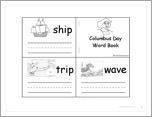Read about the Italian explorer Christopher Columbus and his various voyages from Europe to the Americas.
Christopher Columbus (1451-1506) was an Italian explorer who sailed across the Atlantic Ocean in 1492, hoping to find a route to India (in order to trade for spices). He made a total of four trips to the Caribbean and South America during the years 1492-1504.
The First Trip
Columbus sailed for King Ferdinand II and Queen Isabella of Spain. On his first trip, Columbus led an expedition with three ships, the Niña (captained by Vicente Yáñez Pinzon), the Pinta (owned and captained by Martin Alonzo Pinzon), and the Santa Maria (captained by Columbus), and about 90 crew members. They set sail on Aug. 3, 1492 from Palos, Spain, and on October 11, 1492, spotted the Caribbean islands off southeastern North America. They landed on an island they called Guanahani, but Columbus later renamed it San Salvador. They were met by the local Taino Indians, many of whom were captured by Columbus’ men and later sold into slavery. Columbus thought he had made it to Asia, and called this area the Indies, and called its inhabitants Indians.
While exploring the islands in the area and looking for gold to loot, Columbus’ men traveled to the islands of Hispaniola (now divided into Haiti and the Dominican Republic), Cuba, and many other smaller islands. On the return trip, the Santa Maria was wrecked and the captain of the Pinta sailed off on his own to try to beat Columbus back. Columbus returned to Spain in the Nina, arriving on March 15, 1493.
In 1492, Columbus sailed from Spain with three ships. Two of the ships, the Niña and the Pinta were small caravels. The third ship, the Santa Maria, was a larger type of ship, a carrack, and was captained by Columbus. The ships were from 15 to 36 meters long.
The Second Trip
On a second, larger expedition (Sept. 25, 1493-June 11, 1496), sailed with 17 ships and 1,200 to 1,500 men to find gold and capture Indians as slaves in the Indies. Columbus established a base in Hispaniola and sailed around Hispaniola and along the length of southern Cuba. He spotted and named the island of Dominica on November 3, 1493.
The Third Trip
Captain Christopher Columbus’ ensign (banner) pictured a cross and the crown-topped initials F (for King Ferdinand of Spain) and Y (for Queen Isabella of Spain).
On a third expedition (May 30, 1498-October 1500), Columbus sailed farther south, to Trinidad and Venezuela (including the mouth of the Orinoco River). Columbus was the first European since the Viking Leif Ericsson to set foot on the mainland of America.
The Fourth Trip
On his fourth and last expedition (May 9, 1502-Nov. 7, 1504), Columbus sailed to Mexico, Honduras and Panama (in Central America) and Santiago (Jamaica). Columbus is buried in eastern Hispaniola (now called the Dominican Republic).
Columbus Day Books to Print
A tiny, printable book about simple words related to Columbus Day – for early readers and writers. The book has 2 pages to print and makes 8 pages for the student to cut out, color, and write in. The words are: ship, trip, wave, ship, trip, wave, and “Can you think of another Columbus Day word?”
A short activity book on Christopher Columbus for early readers with connect-the-dots, color the map, do a ship maze, fill in the letters to label the ship, match the sails, finish the Columbus portrait, unscramble the words, do a wordfind puzzle, and do a word path puzzle.
Related Pages
Columbus Day Crafts and activities for kids; learn about geography and history while doing fun projects. Kindergarten, preschool, and elementary school crafts. Make wonderful, simple crafts with things found around the house.
A map activity on Columbus’ 1492 voyage to the New World. Or go to the answers.
Use the list of spelling words to answer simple questions. Words: ship, explorer, voyage, compass, ocean, Columbus, Europe, island, Santa Maria, king. Or go to the answers.
In this puzzle, combine pairs of word segments to make Columbus Day related spelling words. Words: captain, compass, cartography, explorer, island, king, ocean, queen, sailor, spices, voyage, world. Or go to the answers.
Use the word bank to find synonyms of common words. Words: voyage/trip, ships/boats, map/chart, land/place, king/ruler, long/lengthy, difficult/hard, discovering/finding, sea/ocean, New World/America. Or go to the answers.
An outline map of the world to print (countries not marked).
An outline map of the Caribbean to print.
An outline map of the Dominican Republic to print.
An outline map of Haiti to print.
This is a word bank of Columbus Day words.


